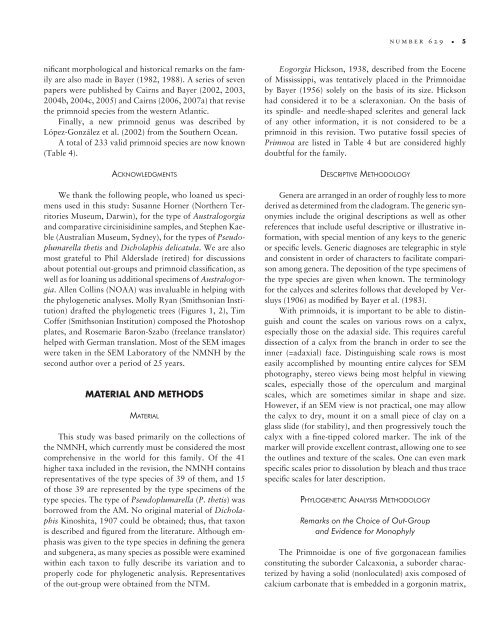A Generic Revision and Phylogenetic Analysis of the Primnoidae
A Generic Revision and Phylogenetic Analysis of the Primnoidae
A Generic Revision and Phylogenetic Analysis of the Primnoidae
You also want an ePaper? Increase the reach of your titles
YUMPU automatically turns print PDFs into web optimized ePapers that Google loves.
nifi cant morphological <strong>and</strong> historical remarks on <strong>the</strong> family<br />
are also made in Bayer (1982, 1988). A series <strong>of</strong> seven<br />
papers were published by Cairns <strong>and</strong> Bayer (2002, 2003,<br />
2004b, 2004c, 2005) <strong>and</strong> Cairns (2006, 2007a) that revise<br />
<strong>the</strong> primnoid species from <strong>the</strong> western Atlantic.<br />
Finally, a new primnoid genus was described by<br />
López-González et al. (2002) from <strong>the</strong> Sou<strong>the</strong>rn Ocean.<br />
A total <strong>of</strong> 233 valid primnoid species are now known<br />
(Table 4).<br />
ACKNOWLEDGMENTS<br />
We thank <strong>the</strong> following people, who loaned us specimens<br />
used in this study: Susanne Horner (Nor<strong>the</strong>rn Territories<br />
Museum, Darwin), for <strong>the</strong> type <strong>of</strong> Australogorgia<br />
<strong>and</strong> comparative circinisidinine samples, <strong>and</strong> Stephen Kaeble<br />
(Australian Museum, Sydney), for <strong>the</strong> types <strong>of</strong> Pseudoplumarella<br />
<strong>the</strong>tis <strong>and</strong> Dicholaphis delicatula. We are also<br />
most grateful to Phil Alderslade (retired) for discussions<br />
about potential out-groups <strong>and</strong> primnoid classifi cation, as<br />
well as for loaning us additional specimens <strong>of</strong> Australogorgia.<br />
Allen Collins (NOAA) was invaluable in helping with<br />
<strong>the</strong> phylogenetic analyses. Molly Ryan (Smithsonian Institution)<br />
drafted <strong>the</strong> phylogenetic trees (Figures 1, 2), Tim<br />
C<strong>of</strong>fer (Smithsonian Institution) composed <strong>the</strong> Photoshop<br />
plates, <strong>and</strong> Rosemarie Baron-Szabo (freelance translator)<br />
helped with German translation. Most <strong>of</strong> <strong>the</strong> SEM images<br />
were taken in <strong>the</strong> SEM Laboratory <strong>of</strong> <strong>the</strong> NMNH by <strong>the</strong><br />
second author over a period <strong>of</strong> 25 years.<br />
MATERIAL AND METHODS<br />
MATERIAL<br />
This study was based primarily on <strong>the</strong> collections <strong>of</strong><br />
<strong>the</strong> NMNH, which currently must be considered <strong>the</strong> most<br />
comprehensive in <strong>the</strong> world for this family. Of <strong>the</strong> 41<br />
higher taxa included in <strong>the</strong> revision, <strong>the</strong> NMNH contains<br />
representatives <strong>of</strong> <strong>the</strong> type species <strong>of</strong> 39 <strong>of</strong> <strong>the</strong>m, <strong>and</strong> 15<br />
<strong>of</strong> those 39 are represented by <strong>the</strong> type specimens <strong>of</strong> <strong>the</strong><br />
type species. The type <strong>of</strong> Pseudoplumarella (P. <strong>the</strong>tis) was<br />
borrowed from <strong>the</strong> AM. No original material <strong>of</strong> Dicholaphis<br />
Kinoshita, 1907 could be obtained; thus, that taxon<br />
is described <strong>and</strong> fi gured from <strong>the</strong> literature. Although emphasis<br />
was given to <strong>the</strong> type species in defi ning <strong>the</strong> genera<br />
<strong>and</strong> subgenera, as many species as possible were examined<br />
within each taxon to fully describe its variation <strong>and</strong> to<br />
properly code for phylogenetic analysis. Representatives<br />
<strong>of</strong> <strong>the</strong> out-group were obtained from <strong>the</strong> NTM.<br />
number 629 5<br />
Eogorgia Hickson, 1938, described from <strong>the</strong> Eocene<br />
<strong>of</strong> Mississippi, was tentatively placed in <strong>the</strong> <strong>Primnoidae</strong><br />
by Bayer (1956) solely on <strong>the</strong> basis <strong>of</strong> its size. Hickson<br />
had considered it to be a scleraxonian. On <strong>the</strong> basis <strong>of</strong><br />
its spindle- <strong>and</strong> needle-shaped sclerites <strong>and</strong> general lack<br />
<strong>of</strong> any o<strong>the</strong>r information, it is not considered to be a<br />
primnoid in this revision. Two putative fossil species <strong>of</strong><br />
Primnoa are listed in Table 4 but are considered highly<br />
doubtful for <strong>the</strong> family.<br />
DESCRIPTIVE METHODOLOGY<br />
Genera are arranged in an order <strong>of</strong> roughly less to more<br />
derived as determined from <strong>the</strong> cladogram. The generic synonymies<br />
include <strong>the</strong> original descriptions as well as o<strong>the</strong>r<br />
references that include useful descriptive or illustrative information,<br />
with special mention <strong>of</strong> any keys to <strong>the</strong> generic<br />
or specifi c levels. <strong>Generic</strong> diagnoses are telegraphic in style<br />
<strong>and</strong> consistent in order <strong>of</strong> characters to facilitate comparison<br />
among genera. The deposition <strong>of</strong> <strong>the</strong> type specimens <strong>of</strong><br />
<strong>the</strong> type species are given when known. The terminology<br />
for <strong>the</strong> calyces <strong>and</strong> sclerites follows that developed by Versluys<br />
(1906) as modifi ed by Bayer et al. (1983).<br />
With primnoids, it is important to be able to distinguish<br />
<strong>and</strong> count <strong>the</strong> scales on various rows on a calyx,<br />
especially those on <strong>the</strong> adaxial side. This requires careful<br />
dissection <strong>of</strong> a calyx from <strong>the</strong> branch in order to see <strong>the</strong><br />
inner (=adaxial) face. Distinguishing scale rows is most<br />
easily accomplished by mounting entire calyces for SEM<br />
photography, stereo views being most helpful in viewing<br />
scales, especially those <strong>of</strong> <strong>the</strong> operculum <strong>and</strong> marginal<br />
scales, which are sometimes similar in shape <strong>and</strong> size.<br />
However, if an SEM view is not practical, one may allow<br />
<strong>the</strong> calyx to dry, mount it on a small piece <strong>of</strong> clay on a<br />
glass slide (for stability), <strong>and</strong> <strong>the</strong>n progressively touch <strong>the</strong><br />
calyx with a fi ne-tipped colored marker. The ink <strong>of</strong> <strong>the</strong><br />
marker will provide excellent contrast, allowing one to see<br />
<strong>the</strong> outlines <strong>and</strong> texture <strong>of</strong> <strong>the</strong> scales. One can even mark<br />
specifi c scales prior to dissolution by bleach <strong>and</strong> thus trace<br />
specifi c scales for later description.<br />
PHYLOGENETIC ANALYSIS METHODOLOGY<br />
Remarks on <strong>the</strong> Choice <strong>of</strong> Out-Group<br />
<strong>and</strong> Evidence for Monophyly<br />
The <strong>Primnoidae</strong> is one <strong>of</strong> fi ve gorgonacean families<br />
constituting <strong>the</strong> suborder Calcaxonia, a suborder characterized<br />
by having a solid (nonloculated) axis composed <strong>of</strong><br />
calcium carbonate that is embedded in a gorgonin matrix,

















